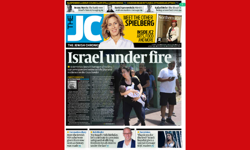Only a couple of years ago, simply being able to replicate a printed magazine on a tablet felt like the epitome of high-tech publishing. But as more publishers have started to experiment and become more confident on the medium, so the digital magazine has evolved into a more interactive and deeper experience, using audio, video, gallery, web links and social media to provide readers with a much more intense and interactive environment. And the "born digital" publishers are far more willing to test the boundaries of the platform than print-heritage magazines.
The Digital Magazine Awards have tracked this evolution over the last three years, and with entries from across the world, they provide a great insight into how the next generation of digital magazines are exploring the boundaries of the medium. Reviewing the shortlist, I have picked out some of the new features of successful digital magazines and suggested titles for further reading. As well as traditional publishers, it's worth watching the growth of digital customer magazines - with Tesco Technology & Entertainment, Morrison’s, Silverkris and Mazda's Zoom Zoom increasingly approaching the depth and production values of paid-for magazines.
In 2013, for the first time, the Digital Magazine Awards ran a half-day unconference, where digital publishers from around the world discussed the practical issues around platform selection, content creation, getting noticed in app stores and growing ad revenues. Some of the key insights are gathered in this article.
14 trends in the next generation of digital magazines
1. Smart navigation
One of the challenges of reading a new digital magazine is learning the layout and how to navigate the edition, plus discovering how to unlock all the added value content. Each title and platform has its own shorthand and icons, and we can only hope that over time they will converge to a common set of rules. By far the easiest layout to visualise is the "washing line" where you swipe horizontally to reach the next feature and down to view all the pages. Some have a useful progress bar so you know how far down you have dived and how much is still to go. With some magazines, a simple explanatory page outlines the key navigation tools, such as video, galleries, pull-out captions or web links. Special mention to Tesco Technology & Entertainment, Australian National Geographic and Top Gear for simple navigation. Many features are now adopting navigation to subsections via images or icons on the opening page of the feature - far more intuitive for readers. Tesco Technology & Entertainment and EDGE magazine do this particularly well.
2. Video content
Video marks out the tablet magazine and can really bring the magazine to life. Some publications like BOYD provide video clips as added value to a core feature, others like Australian National Geographic use video to enhance long copy that has already appeared in the print mag. Bande à part - a French movie magazine - makes liberal use of film trailers. Computer Arts includes video clips of designers explaining the story behind key projects. There is a definite split between those that include embedded video - creating painful download times but a smoother viewing experience - and those that use YouTube links, such as Esquire Weekly, which mean a lighter download but no service when you are offline.
3. Illustration and graphics
These provide a nice contrast to live action video content and the flowing nature of digital magazines can create a variety of moods while reading, with subtle animations. Worth checking out Bande à part for their notebook visuals, and use of French style cartoons (aka bandes dessines), TLQ for some smart illustrations of business and political issues and EDGE for highly appropriate game reviews.
4. Scrolling text
Digital magazines can pack in very long copy, and publishers adopt a wide range of techniques for showing scrolling text. It's crucial to make it clear how the reader can scroll. Bande à part creates fabulous floating text that simply glides over faded out images and graphics.
5. Depth for the exploratory reader
Digital publications can pack in far more content than a standard magazine and act as a multi-media resource for the keen reader, making them much more likely to be saved and referred to. Computer Arts provides in-depth project casebooks, with video, designer profiles and galleries. And EDGE does the same with its game reviews.
6. Photo galleries
Tablets provide a fabulous showcase for extensive galleries, and allow readers to enjoy great images without intruding text. Australian National Geographic's photographer of the year gallery is particularly breathtaking, and BOYD uses their archive of yachting images to great effect.
7. Step by step
LeNs magazine (for Nikon owners) uses a smart side-swipe to take readers through photographic techniques - a really economic use of space. And recipe cards in Jamie Magazine or BBC Good Food have a cooking mode for readers to follow step by step.
8. Audio
Often overlooked in favour of video, audio is less memory hungry and can communicate an authentic experience. Yachting mag BOYD uses audio extensively for interviews on location. Esquire Weekly features custom playlists and music magazine Clash samples its reviewed artists. But the most imaginative use of audio was Top Gear with clips from a selection of supercars revving their engines. Does nothing for me but I am sure it is sweet music for petrolheads.
9. Social links
The fourth wall for apps is the readers themselves. Many publications are now experimenting with user-contributed content and social links. Mazda's Zoom Zoom mag has a whole section of readers' cars and their stories, and fashion mag Katachi includes a wall of photos submitted by readers, in a feature that expanded as more were added. TLQ features live updates on the twitter connections of thought leaders.
10. Animations
Many titles have animated covers or feature openers. EDGE picks up on the themes of the computer games it reviews. HEAPS, an imaginative magazine for Japanese nationals in NYC, has animated food trucks on a feature about how to start up such a business, and many other flashy animations. Sometimes these go too far, but they do surprise and entertain the reader.
11. Big images and 360 views
Some images are too large to fit on a tablet screen, so readers are encouraged to scroll sideways. Contxt, the magazine of a US design college, employs this well for feature covers, as does EDGE for game panoramas. And Travel & Escape magazine includes a 360 view in each edition that can be explored by physically rotating the tablet.
12. Interaction
Several magazines are testing out interactive features. BOYD has a hidden image that readers have to uncover by rubbing the screen. Katachi has several touchy feely pages - where the reader can change the appearance of the image by touching it. And Silverkris, the magazine of Singapore Airlines, provides a strangely addictive puzzle where you guess a location from a grid of squares.
13. Smart sponsorship
With advertisers reluctant to pay a premium for flat ads, many digital publishers are developing clever ways to create sponsorship packages. BOYD has worked closely with Bentley to integrate their brand into their publications.
14. Shopping
Adding ‘Buy Now’ web links to product features is a popular technique. Esquire Weekly makes it easy to buy each item in a fashion feature. And Tesco Technology & Entertainment magazine is designed to drive purchases. Songlines, the world music magazine, connects its readers directly to Amazon or iTunes to buy featured albums.
Building a profitable business…
While all this content innovation is all very well, how are digital publishers to make a profit, especially if they don't have a print-based business to subsidise the start-up phase? The DMA unconference tackled this issue as well as the content and design dilemmas, so here is some advice from the frontline…
* Being found on digital newsstands
The dilemma for digital only publications is whether to go into Newsstand or stay out on the App Store. App Store works best for print titles but the rules can be constraining and it’s increasingly crowded. Apple’s criteria for featuring titles are opaque: interaction, innovation, strong user reviews and a good relationship seem to help. But outside in the App Store, it's more flexible and you can keep more of your revenues by selling subscriptions via the web. The consensus was it’s best to build up your social and email assets and promote your magazine directly to your audience. Offline promotion from print or live events is helpful, but some believe it only drives 10-15% of downloads.
* Growing digital advertising
Publishers with print titles need to resist the temptation to bundle digital ads for free. While digital volumes may be low, engagement is high, so they need to start an educational process with advertisers and agencies and share analytics on dwell time. Some publishers have created a premium priced (+25%) bundle for print plus digital, and offer no discount if advertisers say they don't want digital. B2B publishers with logins can more easily build data on their audience and their behaviour. Many publishers have to create ads for their advertisers that provide the engagement to make the most of the medium. With most apps having a global audience, the trick is finding advertisers who positively seek international exposure. LOOP digital media has transformed its business by switching from print to iPad, losing some UK small advertisers but gaining global players like Gulfstream.
* Choosing the right platforms
Sticking to Apple devices is not a bad choice, but in many markets, the growth will be in Android. Morrison’s magazine sees Android as likely to be a larger part of its audience. But Android is fragmented and this can only get worse, with multiple screen sizes. Best approach could be to try a standard template that isn't device-optimised and watch the analytics, only upgrading to bespoke versions once the numbers justify this. Some believe that with continued fragmentation, the mobile web will re-emerge as more appealing than native apps.
So to avoid getting stuck in the print-heritage replica rut, I do recommend you take some time out in the dark winter evenings with your shiny new tablet, to sample a few of the magazines on the DMA shortlist. Some are mildly outrageous, but it will make you think harder about how the medium can be used to engage readers and capture value from advertisers.












